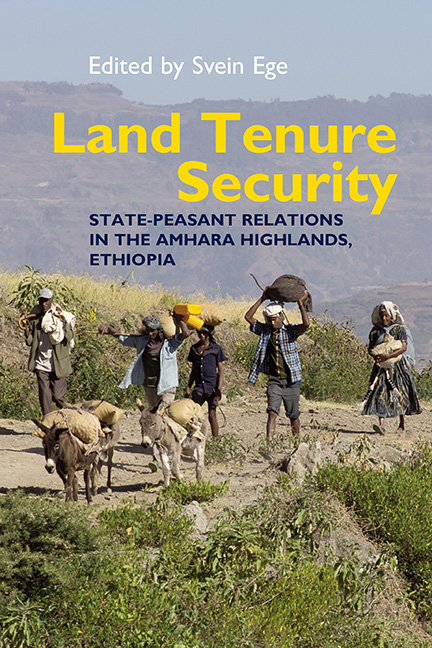Book contents
- Frontmatter
- Dedication
- Contents
- List of Illustrations
- Note on Transliteration
- Dates and Measures
- Contributors
- Preface
- Glossary
- Map
- 1 Introduction
- 2 Peasant Land Tenure: A Critical Review
- 3 The Dersha System: Rethinking Land Tenure under the Därg
- 4 Land Tenure in Gojam under the Därg
- 5 Land Tenure in Baba Säat, North Wälo
- 6 Rich and Poor: Land and Wealth in Mäqét, North Wälo
- 7 Rural Land and Urban Aspirations: Future Orientation in a Time of Change
- 8 An Unstable Land Tenure System
- 9 Conclusion
- Postface
- Select Bibliography
- Index
- Eastern African Studies
3 - The Dersha System: Rethinking Land Tenure under the Därg
Published online by Cambridge University Press: 26 March 2019
- Frontmatter
- Dedication
- Contents
- List of Illustrations
- Note on Transliteration
- Dates and Measures
- Contributors
- Preface
- Glossary
- Map
- 1 Introduction
- 2 Peasant Land Tenure: A Critical Review
- 3 The Dersha System: Rethinking Land Tenure under the Därg
- 4 Land Tenure in Gojam under the Därg
- 5 Land Tenure in Baba Säat, North Wälo
- 6 Rich and Poor: Land and Wealth in Mäqét, North Wälo
- 7 Rural Land and Urban Aspirations: Future Orientation in a Time of Change
- 8 An Unstable Land Tenure System
- 9 Conclusion
- Postface
- Select Bibliography
- Index
- Eastern African Studies
Summary
The dominant understanding of land tenure after the land reform is that there were periodic land redistributions, notably to accommodate youngsters coming of age. This has significant policy implications due to the tenure insecurity such a system would have created. In this chapter, I argue that this is a theory without evidence. Lack of evidence does not by itself falsify the theory, but there is clearly a need for its proponents to provide positive evidence. I also show how one community, which superficially fits the redistribution model, actually worked according to a different principle, the dersha (‘share’) principle. This case is developed into an alternative interpretation. The discussion takes us deep into the issue of peasant land tenure by showing how peasants gained access to and sought to preserve their control over their land, all within the general framework of state land ownership.
The dersha theory is developed based on evidence from Ayné in North Shäwa. This is a core Amhara area, although pre-reform land tenure here was individualized inheritance (rest), not the more communal variant usually associated with the Amhara, which is based on Hoben's (1973) description of a community in Gojam. There is also positive evidence of the dersha system existing in Gojam and other Amhara areas (see Chapter 4). However, the evidence from the other regions of Ethiopia is not precise enough to settle the issue.
There is therefore a strong need to reconsider the received understanding of peasant land tenure in Ethiopia. This does not hinge on the occurrence of the dersha system. Future empirical research may identify specific communities where periodic redistribution took place, although the material presented below makes this the least likely outcome. Alternatively, it may show that the dersha system represented the standard version of the land reform, which seems counterintuitive in view of Ethiopia's great ecological, cultural and social variation. Finally, there may have developed a number of locally grounded property systems, probably variants of family-based property, which would seem the most likely outcome. If so, we need to specify the constituent features of these systems. Even if researchers may ultimately confine the dersha system to certain communities, cultures or regions, the theory outlined in this chapter will be useful to contrast and precisely identify the elements that shape the various peasant land tenure systems.
- Type
- Chapter
- Information
- Land Tenure SecurityState-peasant relations in the Amhara Highlands, Ethiopia, pp. 41 - 67Publisher: Boydell & BrewerPrint publication year: 2019



